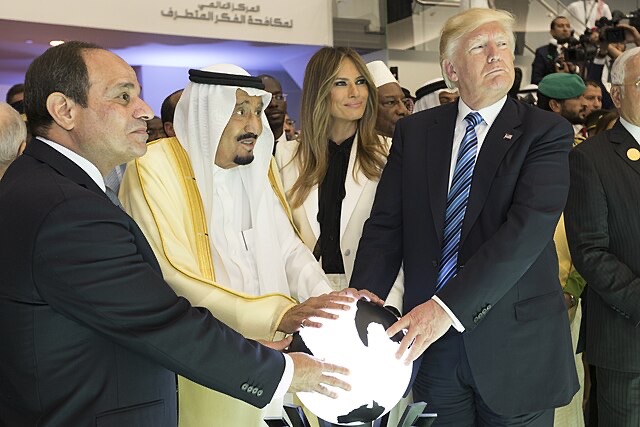In a dramatic pivot in American foreign policy, President Donald Trump has declared the end of U.S. sanctions on Syria during his high-profile visit to Saudi Arabia. This move is part of a broader strategy to strengthen diplomatic and economic ties with Gulf nations, notably Saudi Arabia and the United Arab Emirates. The announcement came as Trump continues his efforts to recast America’s role in the Middle East, this time focusing less on military intervention and more on strategic partnerships and regional stability.
This unexpected decision signals a shift away from decades of isolationist policy towards Syria, reflecting both changing dynamics in the region and Trump’s continued pursuit of influence in global affairs. With the Syrian civil war nearing a political resolution and a new interim government in place, Trump is pushing for economic rehabilitation and integration rather than punishment and estrangement.
The Landmark Decision: Lifting Sanctions on Syria
The U.S. sanctions on Syria have been a longstanding tool aimed at pressuring the Assad regime for human rights abuses, chemical attacks, and its role in regional destabilization. These sanctions covered a wide array of restrictions, targeting individuals, state institutions, and economic entities, effectively crippling Syria’s ability to engage in global trade and finance.
Trump’s decision to lift these sanctions follows significant political developments in Syria, including the ousting of President Bashar al-Assad and the rise of a transitional leadership led by Ahmed al-Sharaa. In his statement, Trump said, “It’s time we gave Syria a fresh start—its people have suffered long enough.” He framed the move as a humanitarian gesture and a calculated geopolitical strategy, aimed at welcoming Syria back into the international fold while curbing the influence of Iran and Russia.
Critics, however, argue that lifting sanctions without substantial democratic reforms could embolden regional autocrats. But Trump’s camp insists that this is a calculated risk intended to reward political transition and incentivize reform through engagement rather than isolation.
U.S.-Saudi Relations at the Forefront
Trump’s announcement came during his visit to Riyadh, where he was warmly received by Crown Prince Mohammed bin Salman. The visit underscored the evolving nature of U.S.-Saudi relations—from oil-driven security pacts to high-tech and defense partnerships.
A landmark $142 billion defense deal was signed, cementing the nations’ security cooperation. But perhaps more notable were the non-military agreements: strategic partnerships in energy, artificial intelligence, digital infrastructure, and mining. Trump praised these deals as a sign of “mutual growth and prosperity” and reiterated his belief in “peace through commerce.
Crown Prince Mohammed bin Salman, in turn, lauded the lifting of sanctions as a bold step that would help rebuild Syria and encourage regional cooperation. This move has sparked speculation about deeper regional integration efforts, potentially paving the way for a broader Middle Eastern economic bloc.
Economic Diplomacy in Action
One of the standout features of Trump’s Middle East visit was the emphasis on economic diplomacy. U.S. tech giants like Nvidia, Cisco, and Google announced multi-billion-dollar collaborations with Saudi Arabia and the UAE. These agreements aim to build advanced digital and AI infrastructure across the region, positioning it as a future hub for innovation.
Perhaps the most striking development was the announcement by Saudi data firm DataVolt, which committed to investing $20 billion in U.S. artificial intelligence infrastructure. An additional $80 billion was pledged for transformative technologies across sectors like healthcare, logistics, and clean energy.
This deepening tech partnership marks a turning point. No longer confined to oil and arms, U.S.-Gulf relations are expanding into the tech frontier. Trump hailed these developments as “game changers” that will “secure American jobs, lead innovation, and build the industries of tomorrow.
A Strategic Pivot in the Middle East
Trump’s recent moves reflect a broader recalibration of America’s Middle East strategy. After decades of military entanglements, the focus is shifting towards economic diplomacy, regional integration, and countering rival powers through influence rather than intervention.
One key motivation behind lifting sanctions on Syria is the desire to reduce Iran’s foothold in the region. By re-integrating Syria into the Arab world and global economy, the U.S. hopes to dilute Tehran’s influence and realign Syria’s interests with moderate Sunni powers like Saudi Arabia.
Moreover, Trump’s push for Saudi Arabia to join the Abraham Accords—a series of normalization agreements between Israel and Arab nations—signals his commitment to building a regional peace framework. Though Riyadh has not yet officially joined, Trump’s efforts suggest that diplomatic dominoes may soon fall.
Domestically, however, Trump’s foreign exploits are not without controversy. Recent revelations about a luxury $400 million jet gifted by Qatar have raised ethical questions and accusations of violating the emoluments clause. Yet, his supporters argue that such scrutiny is politically motivated and overlooks the broader diplomatic breakthroughs he is achieving.



